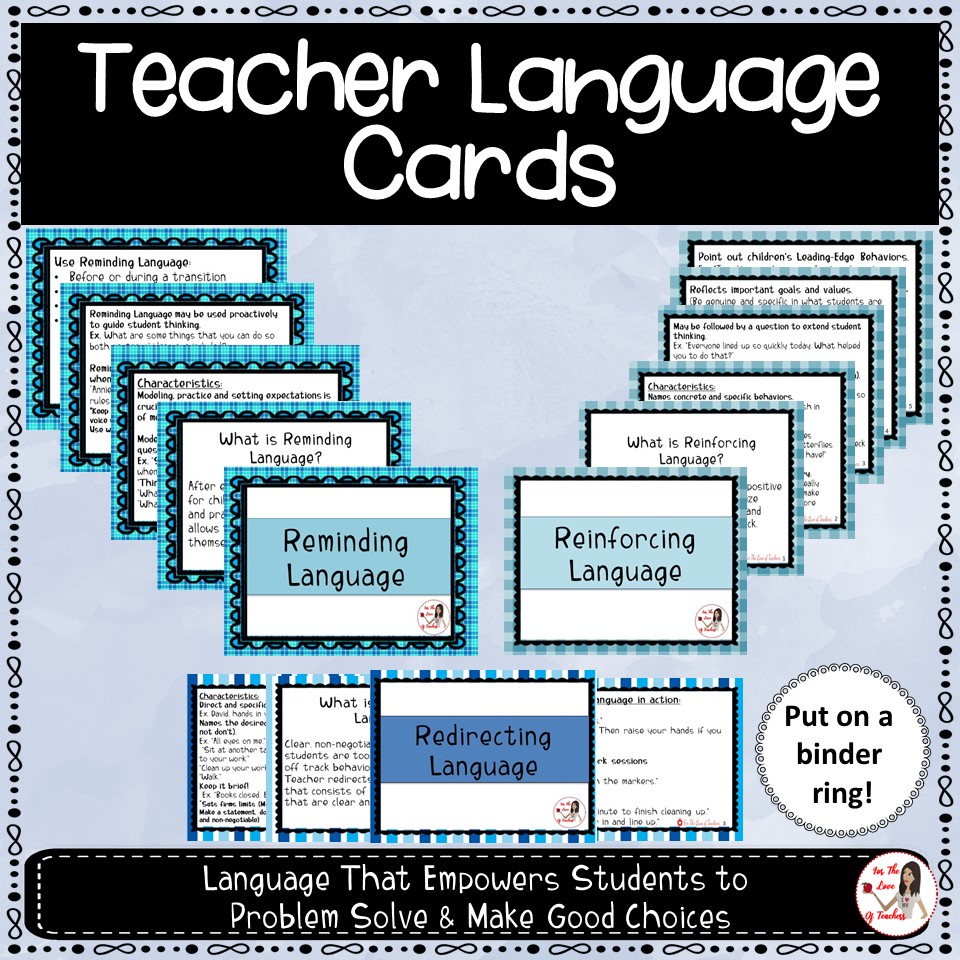Language, along with expression and tone, is powerful. Positive Teacher Language empowers students to make good choices and to problem solve. Early in my career as a teacher, I struggled with what to say to children to redirect, remind and reinforce behaviors, actions, and words until I came across Responsive Classroom’s Positive Teacher Language. It significantly changed the way I interacted with my students. It also became a tool for classroom management and eliminated many repetitive behaviors. Positive Teacher Language empowers students to reflect upon their choices, make better choices and to problem solve. Here’s an overview of Positive Teacher Language and how you could use it in your classroom.
Redirecting Language
Clear, non-negotiable instructions when students are too deeply invested in their off-track behavior to correct themselves. Teacher redirects them with firm words that consist of statements or commands that are clear and respectful of children.
Characteristics:
Direct and specific.
“David, hands in your lap.”
Names the desired behavior (Say do statements, not don’t).
“All eyes on me.”
“Sit at another table where you can pay attention to your work.”
“Clean up your work area.”
“Walk.”
Keep it brief.
“Books closed. Eyes and ears on me.“
Sets firms limits (Mean what you say).
Make a statement, don’t ask a question (Language is firm and non-negotiable).
Redirecting Language in Action:
Group Sessions:
“Use quiet voices.”
“Stop and think. Then raise your hands if you have an idea.”
Independent work sessions
“Use kind words.”
“Take turns with the markers.”
Transitions:
“You have one minute to finish cleaning up.”
“Push your chair in and line up.”
Reinforcing Language
Identifies and affirms children’s positive behaviors. Helps children recognize exactly what they’re doing well and when they are on the right track.
Characteristics:
Names concrete and specific behaviors.
“I see lots of people remembering to push in their chairs before they line up.”
“Did you notice how many different classmates shared thoughtful questions about the butterflies we observed just now? What a long list we have!”
Points out approximations toward mastery.
“We’re well on our way to having some really interesting discussions, what can we do to make them even better?” It would be better if more people said their ideas out loud.”
May be followed by a question to extend student thinking.
“Everyone lined up so quickly today. What helped you to do that?”
Applies to all students (Do not compare children).
“I see more and more children sitting quietly. I see others really working on putting things away so they can be ready soon.”
Emphasizes description over personal approval. (Take away “I loved how…”
You really took your time and made sure to check your work before you turned it in.”
Reflects important goals and values. (Be genuine and specific in what students are doing well, encourage positive behaviors)
“I’m hearing lots of friendly conversations and seeing people helping each other.”
Positive scaffolding and growth.
“You know, I’ve noticed that several children are sitting calmly and listening when others speak, and we’re hearing good ideas from lots of people. What are some other things you’ve noticed that are going well in this discussion?”
Point out children’s behaviors.
“I notice you’re remembering to raise your hand today. That really helped our discussion include lots of different kids’ ideas.”
Reminding Language
After establishing clear expectations for children’s behavior with modeling and practice, reminding language allows the child to think for themselves.
Characteristics:
Modeling, practice and setting expectations is crucial. Children need to see various examples of modeling.
Modeling can be formed as a statement or question:
“Show me how you’ll take care of our chairs when you move them.”
“Think about what will help you concentrate.”
“What do you need to be doing right now?”
“What can you do to solve the problem?”
Reminding Language may be used proactively to guide student thinking.
“What are some things that you can do so both partners’ ideas are included in your plans?” (during a lesson)
Reminding Language may be used reactively when a child’s behavior goes off track.
“Annie and Lucas show me how to follow the rules in the hall.”
Keep reminders brief and watch the tone of your voice when using Reminding Language.
Use when both student and teacher are calm.
Use Reminding Language:
-
Before or during a transition
-
During independent work
-
Before or during an activity
-
Before or during a whole group meeting
Positive words of reinforcement, redirection, and reminding are important in building student-teacher relationships and empowers students to make good choices and to problem solve, an important life skill.
Need more? Check out the book The Power of Words, a must-have resource. You could also visit www.responsiveclassroom.org for more resources to support Positive Teacher Language for a successful school year.
The Power of Our Words: Teacher Language that Helps Children Learn
Follow me to find this freebie and more at:
Teacher Language Cards at For The Love of Teachers Shop
Be sure to join the forums to collaborate with other AMAZING teachers! Follow me to be notified when new resources are uploaded to the Shop and join the email list to receive the latest and greatest updates, posts, and monthly freebies!
If you like it, then pin it!



Christine Weis is a passionate educator, classroom management coach, wife, and mom of two busy boys. She enjoys teaching, writing, and creating resources for teachers.






These are great suggestions. I am going to apply these at home to my kids.
Great idea! I use a lot of these strategies at home with my kids too. Thanks for reading!
Christine at For The Love of Teachers
These are all great learning tips for young children! Great post!
XO-Lisa
http://www.thatssodarling.com
Thanks so much Lisa! Appreciate your comment!
Christine at For The Love of Teachers
Informative and detailed. Thanks for sharing!
Thank you! Appreciate it!
Christine at For The Love of Teachers
Amazing article. Detailed and concise. Great to refer back to. Thank you for sharing!
Thanks Carmen! I appreciate you reading this and commenting! 🙂
Christine at For The Love of Teachers
These are all awesome tips and a few of them I’ve learned through out my education career as well. It’s so important to have these guidelines not only as a teacher but sometimes in life disciplines as well.
Thank you! So true that all adults (parents & teachers) should be modeling positive language to children. Thanks for your comment!
Christine at For The Love of Teachers
Useful practical tips. Some of these are useful at home too. Especially praising a concrete behavior to boost the kid’s confidence. Thanks for such a great list.
Thank you! I agree…modeling and teaching positive language is useful for parents too. I use it at home with my kiddos. Thanks for reading!
Christine at For The Love of Teachers
Positive narration is the best! My administrators always say, “Narrate the world you want to see.” Letting students know what they can do to be successful is definitely more empowering than just pointing out what you want them to stop.
I love that! What a great quote and a great reminder that modeling positive language really changes the way children speak and interact with others. Thanks for your comment!
Christine at For The Love of Teachers
These are great tips for both teachers and parents. We should instill confidences in our children and help them grow as a person. Thanks for sharing.
Thanks Ophelia! I agree… both parents and teachers benefit from using positive language. Thank you for reading!
Christine at For The Love of Teachers
This is a really interesting post! And I think the techniques are definitely effective.
Thanks Margaret! I appreciate your comment!
Thanks for reading!
Christine at For The Love of Teachers
I love your insight! I can see how helpful this can be for parents as well — home and school go hand in hand in shaping children. 🙂
Cheers, Sarah Camille // SCsScoop.com
Thank you Sarah! Good point…I agree! I use this language at home with my kids too.
Thanks for reading!
Christine at For The Love of Teachers
I love this!!
Thanks for reading!
Christine at For The Love of Teachers
I feel like I have been doing this ALL day! It was our first day back to school and this article could not have come at a better time! Thank you for sharing these tips for positive teacher language…such a powerful tool in the classroom! <3
Really thoughtful comments. Even though I’m not a teacher, this method of phrasing can work in a parenting situation.
Yes…exactly! I find myself referring back to positive language when talking to my own children too. Thanks for pointing that out and for reading!
Christine at For The Love of Teachers
I like to use the positives. “I like how (the person right next to the friend not following the expectations) is showing me their rug rules. Good Job! We want to make school a positive place for them.
Absolutely! Modeling positive language encourages others to use positive language. Thanks for reading!
Christine at For The Love of Teachers
I definitely agree with being more aware of the words you use. That all comes from the age old “think before you speak” (:
Ashlee
ashleemoyo.com
Ahhh…yes, exactly! Choosing our words wisely motivates others to think and make good choices.
Thanks for reading!
Christine at For The Love of Teachers